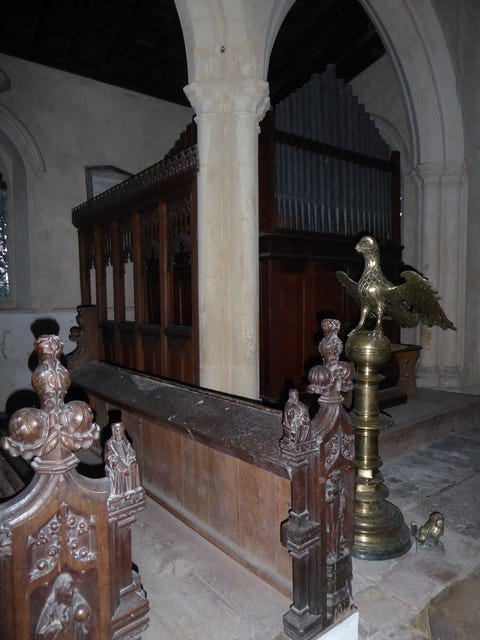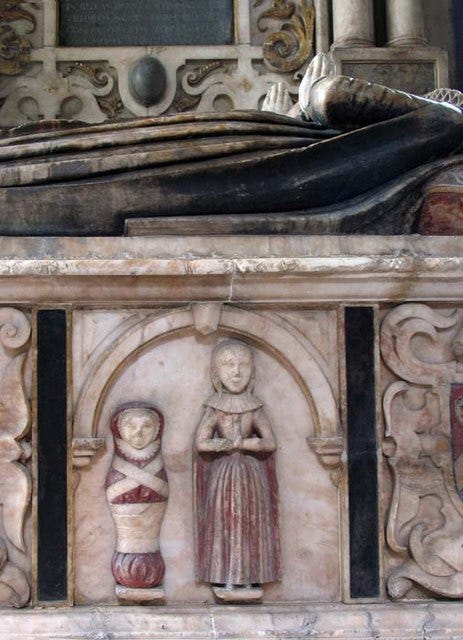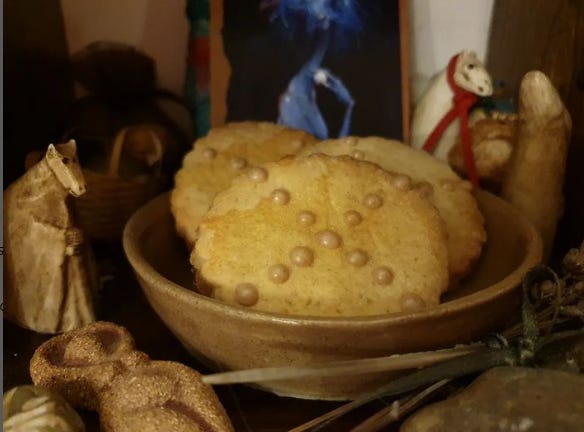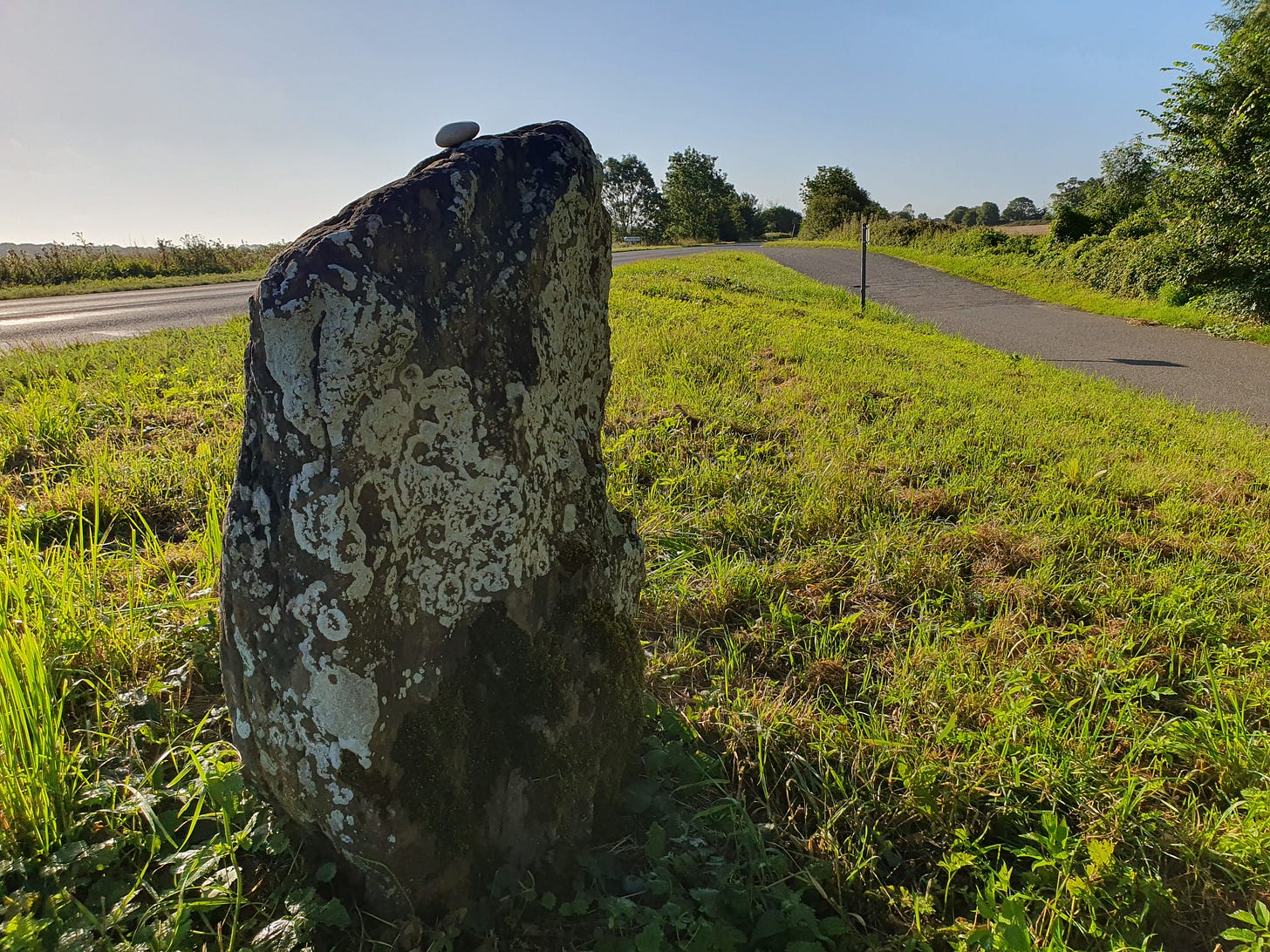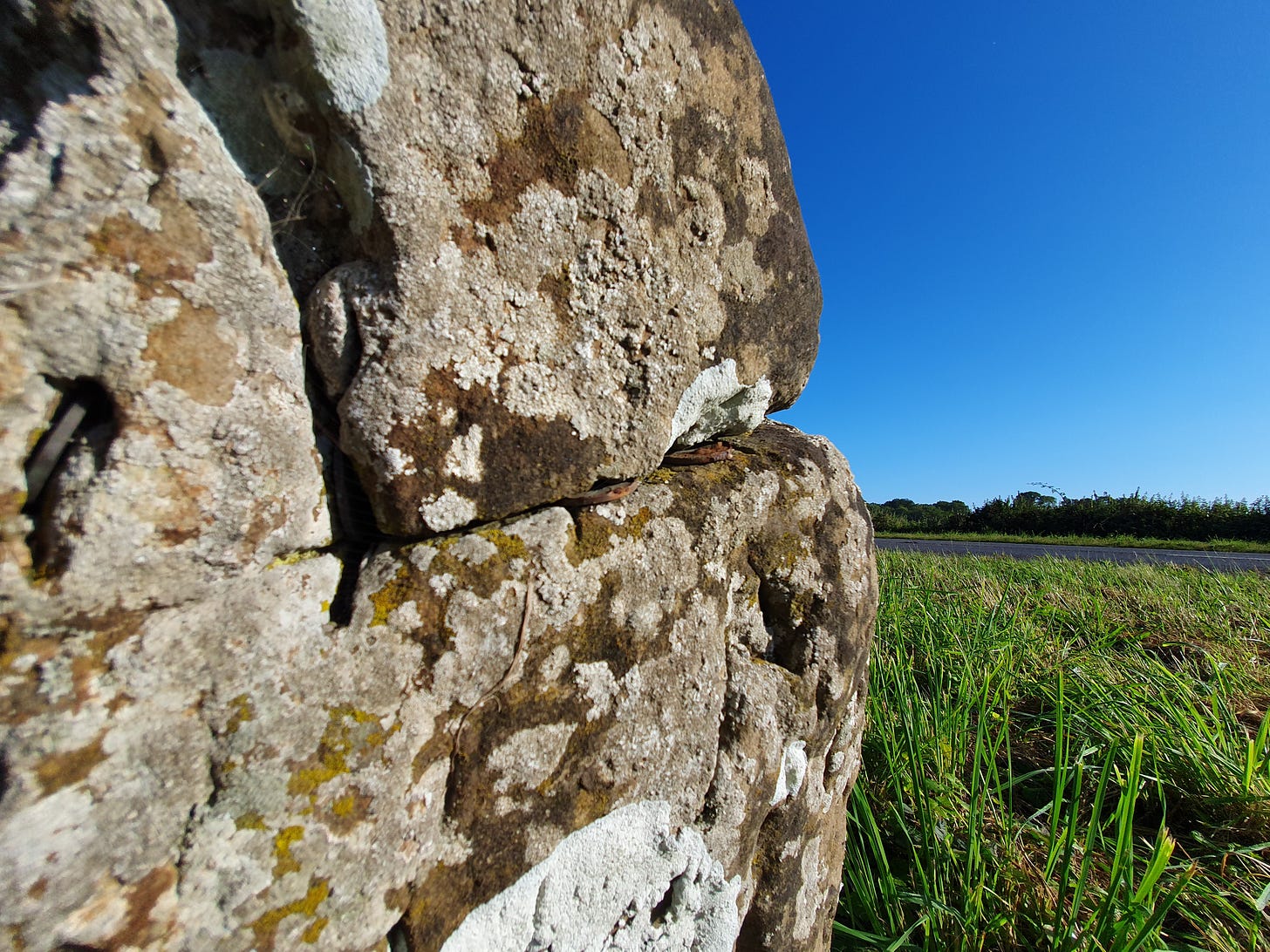A note from Siofra
Hello, my dear folklore friends,
We’re already halfway through the best month of the year! I’m oddly enjoying a quieter October than usual. Normally, we’re completely booked, but this year the only event we have lined up is our first talk at our new venue—which, by the way, sold out super fast again! Feel free to drop me a line if you’d like to join our waiting list.
Things have settled down a bit after our appearance on Charlie Copper’s Myth Country. I wasn’t expecting such an influx of new followers and subscribers, so a big thank you to everyone who took the time to find us. I hope you enjoy our peculiar little offerings.
I think that’s it from me this month. I hope you all have a lovely Samhain and I’ll speak to you again in November.
Siofra💚
A note from Stacia
Apologies for my absence. I am now back, although not firing on all cylinders. Give me time. There is lots to look forward to in terms of the Norfolk Folklore Society with events and podcasts, our recent TV appearance (!) and guest slots on podcasts. We have adventures planned and some very exciting news for 2025. But for now, I am sticking to what I know best: writing stories about strange stuff.
Lots of love, Stacia X
A story for October: The haunted Victorian pipe organ at Wiggenhall
In the eerie marshland in an isolated corner of the Fens stands a church which boasts an unusual ghost watched over by little wooden saints and imposing marble noblemen.
At the redundant church of St Mary the Virgin in Wiggenhall, the most regular visitors to this church close to an orchard and the meandering River Great Ouse are the screaming herring gulls and black-capped terns that wheel overhead on their journey to the mudbanks and marshes of The Wash.
Inside the church, the light is as watery as the landscape outside, the green stained glass casting almost an underwater light over the interior of the building which boasts a weeping chancel, a rare collection of stained glass, four paintings from the original rood screen, 14th-century pews, a six-bell tower…and a haunted organ.
The magnificent Marshland church, one of a clutch which includes the Wiggenhalls, Walpoles, Terringtons and Tilneys, is in the tender care of the Churches Conservation Trust and can be found behind Wiggenhall House, accessed by public footpath through a yard at the side of the private residence. An article in Norfolk Fair in the summer of 1986 recalls the strange story of St Mary’s haunted Victorian organ.
Built by George Maydwell Holdich, whose factory was mentioned by Charles Dickens in A Tale of Two Cities, the organ was donated to the church by the village squire, George Helsham.
“Quite a different kind of ghost is said to haunt the church of St Mary the virgin at Wiggenhall,” he article reads, “now redundant, it is no longer used for services but an atmosphere of unease was said to pervade it when it was in use.
“What was so astonishing was not any spectral apparition but the fact that strains of organ music would be heard, as if some outstanding performer were seated at the instrument.
“Upon investigation, however, no-one could be found, although the organ felt warm. In fact, the generation of heat seemed to be one of the manifestations of whatever moved within the building as it would become warm for no apparent reason.
“This was especially marked at a wedding at which guests became uncomfortably hot and one bridesmaid fainted, yet outside the weather was autumnal and chilly.
“Sometimes the organ behaved so erratically the organist had to give up playing. Yet two or three days later it would perform perfectly. On one occasion, workmen carrying out repairs to the fabric were scared out of their wits when the organ started playing of its own accord.
“They fled the church in panic and only with great difficulty were they persuaded to return. Later visitors to the church have spoken of the strange atmosphere inside the church, which is only open to the public at certain times and which is world-renowned for its exceptional collection of early 16th-century wooden benches with ends carved with likenesses of saints, the detail on which is breathtaking – many believe the endearing faces may well have been based on parishioners of the time.
“Perhaps today they are entertained by spectral music.”
The church has another story attached to it which relates to a brass monument set into the floor and is dedicated to Sir Robert Kervile who died in 1450. The Kervile family were major patrons of the church and Sir Robert’s brass, shaped like a heart, recalls a much-loved man who died while he was abroad.
His heartbroken wife refused to let her husband’s body rest so far from home and sent a monk to find Sir Robert’s body and bring back his heart so it could be buried at Wiggenhall, the place he loved best.
Equally heart-breaking is a nearby memorial to one of Sir Robert’s ancestors, Henry, who died in 1624. Remembered in an alabaster monument in the small chapel to the north of the aisle, the tomb is watched over by Sir Henry’s wife and their two tiny children who tragically died before either of their parents but whose memory lives on in stone.
Shuck Zine 7: Witches
Our pals at Shuck Zine have just released their latest publication with a theme that is VERY exciting – Witches. What better reading material for Halloween…?
Siofra is part of Team Shuck and the newest zine is a patchwork of pieces that in addition to offering some brand new investigations into recent Norfolk covens, male witches, Toad Magic, witch stones and the very first and last witch trials in the county (the latter being only a matter of decades ago), there are also chances for some DIY magic with spells, recipes and even a witch paper doll to dress.
We have our copies and we very much suggest you buy your own – and then several more to give to friends! Buy Shuck 7 HERE.
Halloween
Observed on October 31, Halloween is the Eve of All Soul’s Day and coincides with the ancient Celtic festival of Samhain, which marked the last day of the Celtic year when the Festival of the Dead took place. It was when demons and evil spirits roamed freely and was the night when witches held their most important Sabbats. Bonfires would be lit as protection against evil and charms would be placed in barns to protect livestock from harm.
It was believed that the dead returned to earth on Halloween and another custom was to leave doors open and food on kitchen tables for the souls of departed family members. Despite the somewhat sinister roots of Halloween, people embraced the festival and would use it as a time to tell fortunes and bob for apples, to carve Jack o’ Lanterns and knock at doors in an early form of trick or treating, called ‘guising’. Here we look at some of the old traditions and see how they have formed those we still partake in today.
1. Carving Turnip Lanterns: Before pumpkins became popular, people in Scotland, Ireland, and parts of Northern England would carve lanterns out of turnips or swedes. These were known as “Jack-o’-lanterns” and were used to ward off evil spirits. The folklore around “Jack-o’-lanterns” comes from the Irish myth of Stingy Jack, a man who tricked the Devil and was doomed to wander the earth with only a carved turnip to light his way.
2. Apple Bobbing: A popular Halloween game, bobbing for apples involves trying to catch floating apples with your mouth while keeping your hands behind your back. This tradition is connected to old divination customs. In some regions, the first person to successfully catch an apple would be the next to marry or have good fortune.
3. Nut Burning for Divination: In parts of England, Scotland, and Ireland, Halloween was a night for divination rituals. One such custom was burning hazelnuts in the hearth. Couples would place two nuts, one for each partner, near the fire. If the nuts burned quietly, it was said to indicate a harmonious relationship, but if they popped or cracked, it predicted a rocky future. This ritual was used by unmarried people to predict the success of future relationships.
4. Peeling Apple Skins for Love: In England and Scotland, young people would peel an apple in one long continuous strip and then throw the peel over their shoulder. The peel was believed to land in the shape of the initial of their future spouse.
5. Guising: Guising (from “disguising”) is an old Scottish and Irish tradition that involves children dressing up in costumes and going door to door, performing songs, reciting poems, or telling jokes in exchange for treats, often fruits, nuts, or coins. This practice predated the American “trick-or-treating” and was focused more on performances rather than pranks or asking for sweets.
6. Soul Cakes and Souling: In parts of Northern England and Ireland, “souling” was a practice where the poor would go door-to-door on All Hallows’ Eve, offering prayers for the dead in exchange for soul cakes. These were small, spiced cakes, often marked with a cross, given in exchange for prayers for deceased loved ones. This tradition, associated with the Christian observance of All Saints’ Day and All Souls’ Day, later evolved into aspects of modern trick-or-treating.
7. Lighting Bonfires: In parts of Scotland, Ireland, and Wales, Halloween night (also known as Samhain) was a time to light bonfires. These fires were thought to ward off evil spirits, as Samhain was considered a time when the veil between the living and the dead was thinnest. People would walk around the bonfire or even jump over the flames as a form of protection or purification. In Ireland, it was also common to throw bones into the fire, a possible origin of the term “bone fire” (bonfire).
8. Halloween Food Traditions: In Ireland, a special bread called barmbrack was baked at Halloween, with symbolic items hidden inside, such as a ring (foretelling marriage), a coin (for wealth), or a pea (for poverty). Whoever found the item in their slice was said to have their fortune for the next year predicted. Another food tradition is the “Dumb Supper”, where a meal was served in silence, and seats were left for the spirits of deceased loved ones, who were thought to visit on Halloween night.
9. Seeing Spirits in Mirrors: One old Scottish and English Halloween divination custom involved sitting in front of a mirror at midnight, sometimes with a candle, in the hopes of seeing a glimpse of your future spouse’s face reflected in the glass. However, there was also the fear of seeing a skull or death’s head in the mirror, indicating bad luck or death.
10. Cabbage Stalks: In Scotland and Northern England, children used to pull up cabbage stalks on Halloween night to predict their future spouses. The size and shape of the cabbage were believed to indicate what their future husband or wife would be like. If the stalk was tall and straight, it suggested a prosperous match; a crooked or short one might signal otherwise.
Easy Barmbrack Recipe
Ingredients:
225g (8oz) dried mixed fruit (e.g., raisins, sultanas, currants)
300ml (10 fl oz) hot, strong black tea
75g (3oz) dark brown sugar
1 egg, beaten
225g (8oz) self-raising flour
1 tsp mixed spice (or cinnamon/nutmeg mix)
Optional: a ring, coin, or small charms (wrapped in greaseproof paper if using)
Method:
Soak the fruit: Place the dried mixed fruit into a large bowl. Pour over the hot black tea and stir. Leave to soak overnight (or for at least 4 hours), so the fruit becomes plump and juicy.
Preheat the oven: When ready to bake, preheat your oven to 170°C (150°C fan) or 340°F/gas mark 3. Grease and line a 2lb loaf tin or a round cake tin with baking parchment.
Prepare the batter:
In a separate bowl, mix the self-raising flour, brown sugar, and mixed spice together.
Add the beaten egg to the soaked fruit (do not drain the tea), and stir well.
Gradually mix the wet ingredients into the flour and sugar mixture, stirring gently to form a thick batter.
Add the charms (optional): If you're including the traditional charms, wrap them individually in greaseproof paper and gently fold them into the batter.
Bake: Pour the batter into the prepared loaf tin and smooth the top. Bake in the preheated oven for 1 hour to 1 hour 15 minutes, or until a skewer inserted into the centre comes out clean.
Cool: Allow the barmbrack to cool in the tin for 10 minutes, then transfer it to a wire rack to cool completely.
Serve: Barmbrack is traditionally served sliced, buttered, and enjoyed with a cup of tea. It’s even tastier after being stored for a day or two, giving the flavors time to develop.
Notes: If you’re making it for Halloween, make sure to warn people about the charms hidden inside. NFS is not responsible for dental bills.
You can also substitute the tea with Irish whiskey or add a splash to the batter for extra flavour.
NFS S is for…The Cursed Stone of Stockton
It has stood as a sentinel for centuries, a lonely, lichen-covered reminder of a frozen past when sabre-toothed tigers and woolly mammoths roamed the plains of East Anglia.
Stockton Stone, an oblong sandstone glacial megalith, stands on a grassy slope on the west side of the Beccles to Norwich A146 road, pitted in places but seemingly un-worked, a silent watchtower over a busy thoroughfare that is said to guard a curse which sees misfortune or death befall anyone who sees fit to move it.
There has been a great deal of debate over the original purpose of the stone – some believe it to be the meeting place of the Clavering Hundred, others that it was where the Danegeld, a land tax levied in Anglo-Saxon England during the reign of King Ethelred to raise funds for protection against Danish invaders.
There are theories that the rock was an old mark stone, a Roman milestone or the base of a wayside cross – but it is definitely a glacial erratic, a stone deposited during the movement of a glacier in the last Ice Age, a fragment of the past.
The stone is mentioned in the 1662 Town Books of Stockton which record a small payment for putting “sculps” to the stone, although there are no signs of carving that can be seen – it has been suggested that the record could refer to an old custom that saw nails driven into standing stones (particularly in Scotland) as a cure for toothache. A large steel nail remains driven into the stone.
In The Old Straight Track, by Alfred Watkins, published in 1925, the author postulated that Stockton Stone was one of a network of straight alignments in the area which followed a ley line that can be drawn between Harleston Stone and Stockton, passing directly through a remarkable moated pond at Earsham, called the Lay, onward to an earthwork enclosure on Bungay Common, then through an ancient burial mound on Broome Heath, over Longford Bridge and then on to an artificial mound called Bell Hill and beyond it to Belton Church.
Watkins believed that other mark stones on the Stockton ley line had been hidden by roadside banks or by Christian priests who had been instructed to hide pagan sacred stones out of sight.
Villagers have long been aware of – but unaware of the origin of - the curse attached to the stone that claims death and destruction will dog anyone that moves it: indeed the stone was moved in the 1930s during work to straighten the main road, and photographs in the Lowestoft Journal from July 1935 show the six-feet long stone being lifted under the supervision of Benjamin Edge of Stockton Old Hall, who owned the land and Major S.E Glendenning of the Norfolk Archaeological Society.
Glendenning said the stone had been moved diagonally eastwards by around 14 feet and that the disturbance “was regarded locally with some misgiving”. A document from Suffolk Record Office includes an account of what is said to have happened next:
“Only a few years ago, it was moved during work to straighten out the road and curiously enough, so I gather, one of the workmen involved actually collapsed and died.”
Today, visitors sometimes leave votive offerings as an appeasement to the spirits that have cursed the solitary stone of Stockton and to make amends for the unwanted upheaval.







